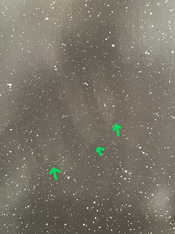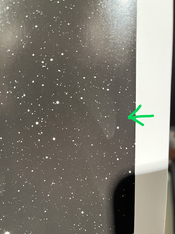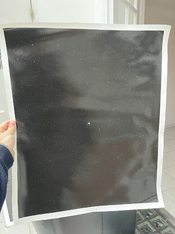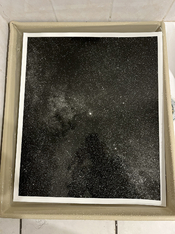fdelconte10
Member
Hi Everybody,
I am having a hard time understanding something happening in the darkroom. I have to print, for an upcoming exhibition, some 50x60 cm photographs, views of the starry sky on 6x7 film. I've made them using an equatorial mount, 40 minutes exposure for each shot. I really like Foma FB glossy paper and I've started using it. The prints come out really well but there is a strange thing happening. Small haloes and stains appear. They are not extremely visible in real life but they bother me a lot. I attached a couple of example. On these sky views they might be more visible then on other types of pictures, let's say landscapes. My working flow is really clean: new chemicals every time, new latex gloves for every final print. I use five liters of chemistry in each tray. I am pretty sure it is a problem of the paper. Has someone experienced something similar?
After some disappointing darkroom sessions, I've decided then to change paper. I am now using Ilford FB paper and I'am having another problem. The photographs are way less contrasty then the previous one made with Foma. The settings of the enlarger are the same ( magenta filter at its maximum) as it is the the developing process. The last time I've used Ilford paper has been many years ago so I am not familiar with it. I wonder, is it a less contrasty paper then Foma? The difference is huge. To show the same amount of stars with the Ilford paper, I need a surprisingly shorter exposure, thus making the sky light gray and not dark. So it is really not an option. If I achieve the proper shade of gray for the sky, I lose so many stars. Does someone has an insight about it? Final consideration, with the Ilford paper I don't have the haloes.
I really need some help friends, it is so frustrating.
Thanks a lot and greetings from Brussels,
Francesco
I am having a hard time understanding something happening in the darkroom. I have to print, for an upcoming exhibition, some 50x60 cm photographs, views of the starry sky on 6x7 film. I've made them using an equatorial mount, 40 minutes exposure for each shot. I really like Foma FB glossy paper and I've started using it. The prints come out really well but there is a strange thing happening. Small haloes and stains appear. They are not extremely visible in real life but they bother me a lot. I attached a couple of example. On these sky views they might be more visible then on other types of pictures, let's say landscapes. My working flow is really clean: new chemicals every time, new latex gloves for every final print. I use five liters of chemistry in each tray. I am pretty sure it is a problem of the paper. Has someone experienced something similar?
After some disappointing darkroom sessions, I've decided then to change paper. I am now using Ilford FB paper and I'am having another problem. The photographs are way less contrasty then the previous one made with Foma. The settings of the enlarger are the same ( magenta filter at its maximum) as it is the the developing process. The last time I've used Ilford paper has been many years ago so I am not familiar with it. I wonder, is it a less contrasty paper then Foma? The difference is huge. To show the same amount of stars with the Ilford paper, I need a surprisingly shorter exposure, thus making the sky light gray and not dark. So it is really not an option. If I achieve the proper shade of gray for the sky, I lose so many stars. Does someone has an insight about it? Final consideration, with the Ilford paper I don't have the haloes.
I really need some help friends, it is so frustrating.
Thanks a lot and greetings from Brussels,
Francesco















